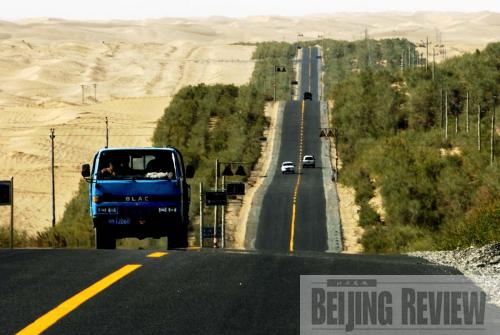|
 |
|
SHEN QIAO DRIVE ON: Great progress has been made in transport facilities in Xinjiang. Desert highways cross Taklamakan Desert, the largest desert in China |
Mamattohti Sawut, 76, is a farmer who plants half a hectare of pomegranate trees in Piyalma Township of Hotan, Xinjiang Uygur Autonomous Region. From the TV set he got free from the township government, he heard the news that railways will soon be built to Hotan. "With railways, my pomegranates can be transported out faster, and I wish to go to Beijing, our capital, by train," he said. "Although I'm old, I still wish to see what Beijing is like."
Railways
The railway that will link Mamattohti Sawut with the outside world is the Kashgar-Hotan Railway. With a total length of 488 km and a total investment of 5.07 billion yuan ($742.31 million), the railway starts from the existing Kashgar Railway Station and ends in Hotan along the southwestern edge of the Taklamakan Desert. Passing through 10 cities and counties, the railway includes 33 newly built stations and is scheduled for completion by the end of 2010.
As Xinjiang is far from the inland of China, more than 95 percent of the goods transported outside and 90 percent of people entering or exiting the region rely on trains.
According to figures from the Urumqi Railway Bureau, by 2008, 3,693 km of railway in nine projects were under construction in Xinjiang. Another six projects that began construction in 2009 will add 6,779 km of railway to the region.
Highways
Before 1949, Xinjiang had no permanent bridges or paved roads.
Since then, and especially since the policy of reform and opening up was adopted in 1978, Xinjiang has made great progress in highway construction. According to figures released by the Communications Department of Xinjiang Uygur Autonomous Region, by the end of 2008, total highway mileage in the region had reached 14,700 km, including two highways across the Tarim Desert with a total length of 672 km. Of all the highways, 1,108 km were expressways.
By the end of 2008, road mileage in rural areas of Xinjiang had reached 92,835 km, of which 28,926 km, or 31.2 percent, were paved or cement roads. Among all the 1,020 townships in Xinjiang, 1,010 have road access and among all the 9,667 villages, 7,540 have road access.
Figures from the Xinjiang Communica-tions Department also showed that, in 2008, construction of highways and related infrastructure in Xinjiang created 618,300 jobs, accounting for 7.27 percent of total employment in the region.
Air
Covering an area of 1.66 million square km, Xinjiang is the largest provincial-level locality in China, accounting for one sixth of the country's total area. The region is three times the size of France, five times Germany and seven times Great Britain.
In such a vast region, aviation plays a particularly important role in meeting transportation needs. For example, from Urumqi to Kanas, the most famous scenic spot in the region, it takes about 14 hours by car, but by air, you only need an hour; from Urumqi to Nalati, which is famous for its pastures, it takes more than 10 hours by bus, but planes will take you there in just one hour. However, before 1978, there were only nine air routes in Xinjiang, connecting 10 cities in the region, with a total annual passenger volume of only 60,000 people. At that time, there was no trans-provincial air route or international air route connecting Xinjiang.
The situation has changed a lot in the past three decades. Xinjiang Airport Group Co. Ltd. operates 14 civil airports, the most of any provincial-level locality in China. China Southern Airlines and Hainan Airlines have established bases in Xinjiang, bringing competition to the region's civil aviation market.
From January to April this year, 33 airlines operated in Xinjiang. Of them, 13 Chinese airlines and 10 international and regional airlines offer regular flights connecting Urumqi. Seventy-nine air routes run through the airport in Urumqi, including 22 international air routes. Urumqi is connected with 43 domestic cities and 21 cities in 13 countries. All five Central Asian countries have flights to Urumqi. |
